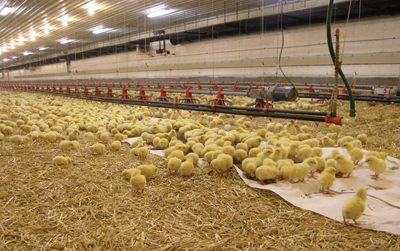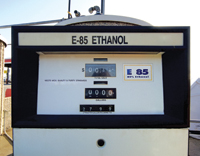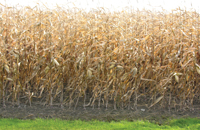
Energy Versus Protein
By Paul Aho
Features Manure Management ProductionHow the Ethanol Equation will affect the future relative cost of corn, soybean meal and DDGs
The most notable debate about biofuels involves the potential trade-off
between food and fuel. Less often mentioned is the relationship between
energy and protein. The global shift to biofuels in the last few years
dramatically increased the demand for feed energy.
The most notable debate about biofuels involves the potential trade-off between food and fuel. Less often mentioned is the relationship between energy and protein. The global shift to biofuels in the last few years dramatically increased the demand for feed energy. As a result, feed energy is relatively more expensive while protein is relatively less expensive. This trend can be expected to continue into the future. Despite the recent setback in the price of crude oil and biofuels the relative values of energy and protein have shifted.
 |
|
| A little mentioned result of the biofuels debate is the resulting cost increase for feed energy. Advertisement
|
Biofuels Background
Until this decade, sugar-based ethanol in Brazil contributed the most to the increase in world biofuels. However, even that massive three-decade effort in Brazil was overshadowed by the recent expansion of U.S. corn-based ethanol production.
According to the USDA, in the 2006-2007 crop year, 2.1 billion bushels of corn were used to produce ethanol, and in this crop year, 2008-2009, 3.6 billion bushels of corn will be used, fully 30 per cent of the U.S. corn crop. The two-year increase in the use of U.S. corn for ethanol is, by itself, greater than the total production of corn in Argentina, the world’s second largest exporter of corn.

|
|
 |
|
| Converting corn into DDG converts a product most valuable for its energy into a product more valuable for protein. |
This huge increase in the volume of corn used by the U.S. ethanol industry sent a shockwave throughout the world’s food system. The price of corn spiked to record levels last year before crashing along with the price of oil.
Just one year ago, biofuel production was climbing exponentially. In addition to sugar- and corn-based ethanol in the Americas, biodiesel was increasing rapidly in Europe, using rapeseed and sunflower seed. In addition, vast areas of Asia were being planted to oil palms destined for conversion to biodiesel.
This year the biofuels boom is slowing due to lower crude oil prices, environmental questions and lack of credit. Beyond these current problems, biofuels have an Achilles heel; the business model of most biofuel production is based on high oil prices combined with government subsidy (with the notable exception of sugar-based ethanol).
When oil prices fell by 75 per cent last year the business models exploded. Large producers of ethanol went bankrupt in the U.S. Nevertheless, the likelihood of high oil prices in the future combined with the political desire to continue providing subsidies to biofuels regardless of economic reality, makes it likely that biofuel production will continue to have an important effect on the price of both corn and soybeans.
Origin of the Corn Ethanol Boom
The origin of the corn-based ethanol boom can be found in the energy crisis of the 1970s, when efforts were made to reduce U.S. dependence on foreign sources of oil.
Policy initiatives in the 1970s included significant increases in the fuel economy of cars combined with a subsidy for the use of gasohol, the mixture of ethanol and gasoline. The subsidy never led to any significant production of ethanol because of the drop in the price of petroleum in the 1980s. Even the word, gasohol, disappeared. What did not disappear was the subsidy; it remained on the books even if there were few takers.
It was difficult for the ethanol industry to become established in the 1980s, even with the subsidy, because of the low price of fossil fuel energy. When oil became more expensive in the last decade the subsidy began to provide an incentive for the expansion of the industry. As the price of oil rose higher and higher, the incentive became compelling. For this reason the ethanol industry experienced explosive growth in the last few years.
Policy choices
United States agricultural policy toward corn production has been characterized by extreme positions over the last several decades. One extreme, that of subsidizing the production of corn regardless of the quantity produced, led to unusually low prices. It was low corn prices (combined with subsidies) that attracted the attention of the world energy sector.
That led to the other extreme, the recent unusually high prices.
The abrupt swing in corn prices from one extreme to the other raises the question of a middle ground. Among practitioners of agricultural policy, the piece of advice often heard is to “get prices right.” A U.S. agricultural policy that gets prices right would be one that avoids policy extremes. There are numerous middle ground suggestions. These include such ideas as variable subsidies, an end to the tariff on imported ethanol, and a limit to the amount of corn that can be used to produce ethanol. If cellulosic ethanol becomes feasible, that could replace corn ethanol. However, it appears that at least another decade will be required before cellulosic ethanol approaches the cost of corn-based ethanol and it is easy to forget that corn-based ethanol is not economically feasible without massive subsidies.
What Happens to a Bushel of Corn at an Ethanol Plant?
When a bushel of corn goes through an ethanol plant it yields approximately 2.75 gallons of ethanol and 18 pounds of distiller’s dried grain (DDG), which is about one-third of the weight of the original corn. With starch gone, the DDG still has corn oil, protein and fibre. In fact, the DDG has about three times as much protein and fibre as the original corn and a similar amount of energy per pound thanks to the corn oil. Therefore, the process of converting corn into DDG converts a product most valuable for its energy into a product more valuable for protein. In addition, given the relatively high amount of fibre and poor quality of protein, it is a product most valuable to the cattle industry and less interesting to the poultry industry.
The net result of producing 32 million tons of DDG this year is to reduce the amount of feed energy available to the animal industries while losing none of the protein in corn. Since the production of corn is artificially high thanks to ethanol, it can be said that both more protein and less energy is available for feed because of the existence of the ethanol industry.
There is another biofuels raw material that affects the price of chicken feed, soybean oil. Similarly to corn, more soybeans are grown due to the artificially high price for soybean oil used in the production of biodiesel. That increases the availability of protein feedstocks while again confiscating a potential source of energy, soybean oil.
Wherever energy is to be found, whether it is starch in corn, oil in soybeans, grease from restaurants or fat from animal slaughter, there is a government-sponsored subsidy to assist in its seizure for the production of liquid fuel for automobiles and trucks.
Energy versus protein
The long-term effect of higher prices for the energy contained in corn, corn oil and soybean oil is to raise the price of energy compared to protein. Over the last decade the ratio of the value of corn to soybean meal (SBM) has dropped. It can be expected that in the future a pound of SBM will be worth only twice as much as a pound of corn. The massive new availability of distiller’s dried grain (DDG) has lowered the ratio of DDG to corn below parity. It can be expected that DDG will continue to have less value than corn in the future.
Conclusion
World biofuel policy artificially increased the value of energy for animal feeding and lowered the relative cost of protein in the last few years. This trend can be expected to continue in the future.
Presented at the 2009 Midwest Poultry Federation Convention in Saint Paul, Minn.
Print this page